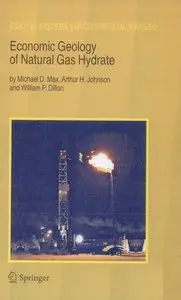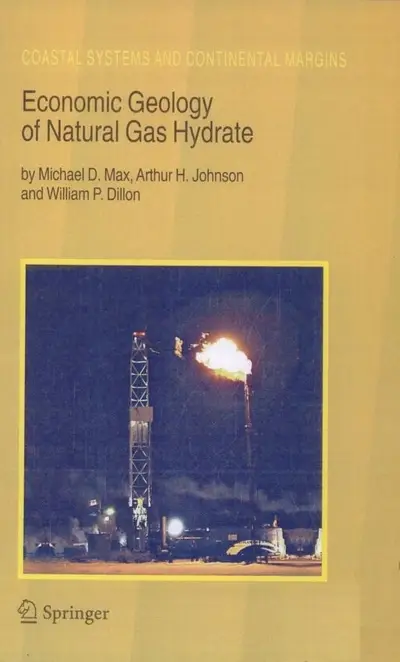"Economic Geology of Natural Gas Hydrate" by Michael D. Max, Arthur H. Johnson, William P. Dillon
Coastal Systems and Continental Margins, Volume 9
Sрringеr | 2006 | ISBN: 1402039719 9781402039713 1402039727 9781402039720 | 361 pages | PDF | 11 MB
Coastal Systems and Continental Margins, Volume 9
Sрringеr | 2006 | ISBN: 1402039719 9781402039713 1402039727 9781402039720 | 361 pages | PDF | 11 MB
This is the first book that attempts to broadly integrate the most recent knowledge in the fields of hydrate nucleation and growth in permafrost regions and marine sediments. The book will be of interest to petroleum geologists, earth scientists (marine geology and geophysics), government departments and institutions concerned with energy resources.
Gas hydrate reactant supply, growth models, and implications for pore fill by natural gas hydrate are discussed for both seawater precursors in marine sediments and for permafrost hydrate. These models for forming hydrate concentrations that will constitute targets for exploration are discussed, along with exploration methods. Thermodynamic models for the controlled conversion of hydrate to natural gas, which can be recovered using conventional industry practices, suggest that a number of different types of hydrate occurrence are likely to be practical sources of hydrate natural gas.
Current progress in the various aspects of commercial development of hydrate gas deposits are discussed, along with the principal extractive issues that have yet to be resolved.
TABLE OF CONTENTS
Preface
Introduction
National Programs for Hydrate Research
Countries with Developed National Hydrate Energy Interests
Countries Showing Early Interest in Hydrate
Terminology of Hydrate and its Processes
Chapter 1. Why Gas Hydrate?
1.1. Introduction
1.2. Reserves versus Markets
1.3. The Case for Unconvenitonal Gas
1.4. Meeting Future Demand
1.5. Options for Increasing North American Gas Supply
1.5.1. Increased Conventional Gas Development
1.5.2. Increased LNG Imports
1.5.3. Concerns for LNG
1.6. Looking to the Future
1.7. The Case for Gas Hydrate
1.8. Current Knowledge of Gas Hydrate Occurrence
1.9. Exploration for Commercial Gas Hydrate Prospects
1.9.1. Overview of Deepwater Production
1.9.2. Models for Recovery
1.9.3. Business Issues
1.10. The Gas Economy: Enhanced Efficiency and Security
1.11. Conclusions
Chapter 2. Physical Chemical Characteristics of Natural Gas Hydrate
2.1. Introduction
2.2. Crystalline Gas Hydrate
2.3. Formation of Gas Hydrate
2.3.1. The Growth Dynamic
2.3.2. Hydrate Growth Inhibition
2.4. Nucleation
2.5. Growth
2.5.1. Effects of Diffusion
2.5.2. Growth from Mixtures of HFG
2.5.3. Hydrate Growth from Different Types of Solution
2.5.4. Example of Hydrate Growth 66
2.6. Hydrate Dissociation and Dissolution
2.6.1. Hydrate Dissociation
2.6.2. Hydrate Dissolution
2.6.3. Dissociation and Dissolution: A Surface Phenomenon
2.6.3.1. Hydrate Dissolution in a Nearly Saturated Environment
2.6.4. “Self Preservation”
2.6.5. The Phase Boundary and Apparent Stability of Hydrate
2.7. Hydrate Growth Models
2.7.1. Circulation of HFG Enriched Groundwater
2.7.2. Diffusion in Solution
2.7.3. Diffusion Through Hydrate and Other Solids
2.7.4. Formation in Gaseous HFG Through Water Vapor Diffusion
2.7.5. Variable Supersaturation
2.7.6. Direct Contact between Gaseous HFG and Water
2.8. Kinetic Considerations
2.9. Best Conditions for Hydrate Concentration
Appendix A. Background Chemistry
A1. Phase Diagrams
A2. Henry’s Law
A3. Number of Water Molecules per Dissolved HFG Molecule
A4. Chemical Potential of Saline Hydrate Inhibition
A5. Mol of Gas Hydrate
A6. Diffusion Mechanism for Hydrate Breakdown
A7. Concentration
A8. Chemical Equations
Chapter 3. Oceanic Gas Hydrate Character, Distribution, and Potential for Concentration
3.1. The Character of Oceanic Gas Hydrate
3.2. Where Gas Hydrate is Found
3.2.1. Where is Gas Hydrate Stable?
3.2.2. Where Do We find Gas Hydrate in Nature
3.3. Identification of Gas Hydrate in Nature
3.3.1. Measuring Gas Hydrate in Wells and Cores
3.3.2. Remote Sensing of Gas Hydrate
3.4. Concentration of Gas Hydrate in Nature
3.4.1. Two Modes of Gas Hydrate Concentration
3.4.1.1. Diffuse Gas-flow Model
3.4.1.2. Focused Gas-flow Model
3.4.2. Lateral Variations that Create Trapping of Gas and Gas Hydrate Concentrations
3.4.2.1. Structural Trapping
3.4.2.2. Physical Variations that Cause Gas Hydrate Concentration
3.4.2.2.1. Fault-controlled Gas Flow
3.4.2.2.4. Tectonic Subsidence
3.5. Conclusion
Chapter 4. Natural Gas Hydrate: A Diagenetic Economic Mineral Resource
4.1. Introduction
4.2. The Source of Hydrate: Generation of Hydrocarbon Gases
4.3. The Rock and Sediment Host
4.3.1. Porosity
4.3.2. Permeability
4.4. Hydrate Growth Regimes
4.4.1. Hydrate Mineralization: The Role of Water in Porous Strata
4.5. Gas Hydrate: A Diagenetic Economic Mineral Deposit
4.6. Classification of Gas Hydrate Deposits
4.6.1. High Grade Deposits
4.6.2. Low Grade Deposits
4.7. Migration of Hydrate-Forming Gas Into and Through the HSZ
4.7.1. Chimneys
4.7.2. Vents
4.8. Implications for Hydrate Concentrations not Directly Associated with a Seafloor-simulating BGHS
4.9. Examples of Stratabound Mineral Deposits
4.10. Conclusions
Appendix B1
Chapter 5. State of Development of Gas Hydrate as an Economic Resource
5.1. Introduction
5.2. Mallik
5.2.1. Background
5.2.2. The 1998 Mallik Program
5.2.3. The 2002 Mallik Program
5.2.4. Planned follow-up and Options
5.3. Nankai
5.3.1. Background
5.3.2. 1999-2000 Nankai Drilling Program
5.3.3004 Nankai Drilling Program
5.3.4. Future work
5.4. Gulf of Mexico
5.4.1. Background
5.4.2. ChevronTexaco Joint Industry Program
5.4.3. MMS Gulf of Mexico Gas Hydrate Assessment
5.5. Alaska
5.5.1. Background
5.5.2. BP Exploration Alaska
5.6. Cascadia Margin
5.6.1. Background
5.6.2. ODP Leg
5.6.3. IODP Expedition
5.7. Messoyakha
5.8. India
5.9. Comment on Hydrate Research: Objectives and Progress
5.10. Conclusions
Chapter 6. Oceanic Gas Hydrate Localization, Exploration, and Extraction
6.1. Introduction
6.2. Gas Hydrate Provincing
6.3. Semi-Quatitative Evaluation of Hydrate Likelihood
6.4. Remote Sensing for the presence of Oceanic Hydrate
6.4.1. Seismic Effects of Hydrate Formation and Exploration
6.4.1.1. Blanking
6.4.1.2. Accentuation
6.4.1.3. Seafloor Acoustic Imagery
6.4.2. Sulfate Reduction Identification
6.4.3. Natural Gas Analysis and Application
6.4.4. Heat Flow / Vent-related Seafloor Features
6.4.5. Electromagnetic Methods
6.5. Exploration for Natural Gas Hydrate Deposits
6.6. Issues concerning Recovery of Gas from Hydrate Deposits
6.6.1. Reservoir Characterization
6.6.1.1 Contrasts Between Hydrate and Conventional Gas Reservoirs
6.6.2. Producing Gas from Oceanic Hydrate In-Situ
6.6.2.1. Extraction Methodology
6.6.3. Drilling
6.6.4. Artificially Induced Permeability
6.6.5. Hydrate and Natural Fracturing
6.6.6. Volume-Pressure Relationships for Hydrate Dissociation at Depth
6.6.7. Safety
6.7. Unconventional Gas Recovery from Hydrate
6.7.1. Dissolution
6.7.2. Low-Grade Deposit Special Issues
6.8. Conclusions
Chapter 7. Gas Production from Unconfined Class 2 Oceanic Hydrate Accumulations
7.1. Introduction
7.2. Background
7.3. Description of the Geologic System
7.4. Objectives
7.4.1.1. Geometry and Conditions of the System
7.4.1.2. Domain Discrimination and Simulation Specifics
7.4.1.3. Results of the Single Well Study
7.4.1.4. Effect of the Initial SH in the HBL
7.4.2. Case 2: Gas Production from a Five-Spot Well
7.4.2.1. Geometry and Conditions of the System
7.4.2.2. Domain Discrimination and Simulation Specifics
7.4.2.3. Results of the Five-Spot Study
7.5. Summary and Conclusions
7.6. Acknowledgements
Chater 8. Regulatory and Permitting Environment for Gas Hydrate
8.1. Introduction
8.2. Regulatory and Permitting Framework
8.2.1. Territorial Sea
8.2.2 The 200 Nautical Mile Exclusive Zone
8.2.3. The Continental Shelf
8.2.4. The Commission on the Limits of the Continental Shelf
8.2.5. Rights of the Coastal State over the Continental Shelf
8.2.6. Legal Status of the Superjacent Waters and Air Space and the Rights and Freedoms of Other States
8.2.7. Submarine Cables and Pipelines on the Continental Shelf
8.2.8. Artificial Islands, Installation and Structures on the Continental Shelf
8.2.9. Drilling on the Continental Shelf
8.2.10. Payments and Contributions with Respect to the Exploitation of the Continental Shelf Beyond 200 Nautical Miles
8.2.11. Delimitation of the Continental Shelf Between States with Opposite or Adjacent Coasts
8.2.12. Tunneling
8.3. Statement of Understanding Concerning a Specific Method to be Used in Establishing the Outer Edge of the Continental Margin
8.4. The Area Beyond the Limits of National Jurisdiction
8.5. The Relationship of the Central Government to Local Authorities
Author Comment
Chaprter 9. Conclusions and Summary
9.1. Conceptualization of the Hydrate Gas Resource
9.2. Gas Hydrate; A New Hydrocarbon Resource at the Right Time
9.3. Gas Hydrate Characterization
9.3.1. Permafrost Hydrate
9.3.2. Oceanic Hydrate
9.3.3. Hydrate Natural Gas Quality
9.4. Hydrate Exploration and Recovery
9.5. Commercial Hydrate Natural Gas Development
Glossary of Terms
Selected References
Miscellaneous Information
Author Address List
Gas Hydrate Fresh Water Reservoirs
Earliest Record of Artificially Produced Gas Hydrate
with TOC BookMarkLinks



